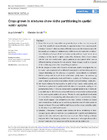Crops grown in mixtures show niche partitioning in spatial water uptake
dc.contributor.author
Schmutz, Anja
dc.contributor.author
Schöb, Christian
dc.date.accessioned
2023-05-10T07:06:14Z
dc.date.available
2023-04-05T04:06:25Z
dc.date.available
2023-04-06T07:05:50Z
dc.date.available
2023-04-11T06:19:20Z
dc.date.available
2023-05-10T07:06:14Z
dc.date.issued
2023-05
dc.identifier.issn
0022-0477
dc.identifier.other
10.1111/1365-2745.14088
en_US
dc.identifier.uri
http://hdl.handle.net/20.500.11850/606662
dc.identifier.doi
10.3929/ethz-b-000606662
dc.description.abstract
More diverse plant communities are generally more productive than monocultures. This benefit of species diversity is supposed to stem from resource partitioning of species in mixtures where different species use the resources spatially, temporally, or chemically in distinct ways. With respect to water, the simultaneous cultivation of crops with distinct water uptake patterns might reduce niche overlaps and thus result in higher productivity. However, little is known about whether and how spatial water uptake patterns of crop species differ among different planting arrangements and whether these changes result in increased niche partitioning and explain overyielding in mixtures. Stable isotopes of water and a Bayesian model were used to investigate the spatial water uptake patterns of six different crop species and how these patterns change depending on the planting arrangement (monocultures vs mixtures). Niche overlaps and niche widths in spatial water uptake were compared among the different crop diversity levels and linked to productivity. Furthermore, spatial water uptake was related to competition intensity and overyielding in mixtures. We found evidence for increased niche partitioning in spatial water uptake, and therefore complementary spatial root distributions of crop species, and higher expected productivity in mixtures compared to expected productivity in monocultures both due to inherent species-level differences in water uptake and plasticity in the water uptake pattern of species. We also found a significant relationship of competition and overyielding with observed patterns in spatial water uptake. These results suggest that competition was most intense in shallow soil layers and enhanced overyielding was related to a gradual increase of water uptake in deeper soil layers. Thus, overyielding might be related to a more complete spatial exploitation of available water sources. Synthesis. Differences in spatial water uptake and niche partitioning of intercropped species, driven most likely by a complementary spatial root distribution, might explain why mixtures outperform monocultures. These findings underpin the potential of intercropping systems for a more sustainable agriculture with a more efficient use of soil resources and hence reduced input demands.
en_US
dc.format
application/pdf
en_US
dc.language.iso
en
en_US
dc.publisher
Blackwell
en_US
dc.rights.uri
http://creativecommons.org/licenses/by-nc/4.0/
dc.subject
competition
en_US
dc.subject
intercropping
en_US
dc.subject
niche overlap
en_US
dc.subject
overyielding
en_US
dc.subject
plasticity
en_US
dc.subject
productivity
en_US
dc.subject
resource partitioning
en_US
dc.subject
spatial root distribution
en_US
dc.subject
spatial water uptake
en_US
dc.subject
stable isotopes
en_US
dc.title
Crops grown in mixtures show niche partitioning in spatial water uptake
en_US
dc.type
Journal Article
dc.rights.license
Creative Commons Attribution-NonCommercial 4.0 International
dc.date.published
2023-03-02
ethz.journal.title
Journal of Ecology
ethz.journal.volume
111
en_US
ethz.journal.issue
5
en_US
ethz.journal.abbreviated
J. Ecol.
ethz.pages.start
1151
en_US
ethz.pages.end
1165
en_US
ethz.version.deposit
publishedVersion
en_US
ethz.grant
Designing innovative plant teams for ecosystem resilience and agricultural sustainability
en_US
ethz.identifier.wos
ethz.identifier.scopus
ethz.publication.place
Oxford
en_US
ethz.publication.status
published
en_US
ethz.grant.agreementno
727284
ethz.grant.fundername
EC
ethz.grant.funderDoi
10.13039/501100000780
ethz.grant.program
H2020
ethz.relation.isSupplementedBy
10.5281/zenodo.7505603
ethz.date.deposited
2023-04-05T04:06:28Z
ethz.source
WOS
ethz.eth
yes
en_US
ethz.availability
Open access
en_US
ethz.rosetta.installDate
2024-02-02T23:01:24Z
ethz.rosetta.lastUpdated
2024-02-02T23:01:24Z
ethz.rosetta.versionExported
true
ethz.COinS
ctx_ver=Z39.88-2004&rft_val_fmt=info:ofi/fmt:kev:mtx:journal&rft.atitle=Crops%20grown%20in%20mixtures%20show%20niche%20partitioning%20in%20spatial%20water%20uptake&rft.jtitle=Journal%20of%20Ecology&rft.date=2023-05&rft.volume=111&rft.issue=5&rft.spage=1151&rft.epage=1165&rft.issn=0022-0477&rft.au=Schmutz,%20Anja&Sch%C3%B6b,%20Christian&rft.genre=article&rft_id=info:doi/10.1111/1365-2745.14088&
Files in this item
Publication type
-
Journal Article [128989]

